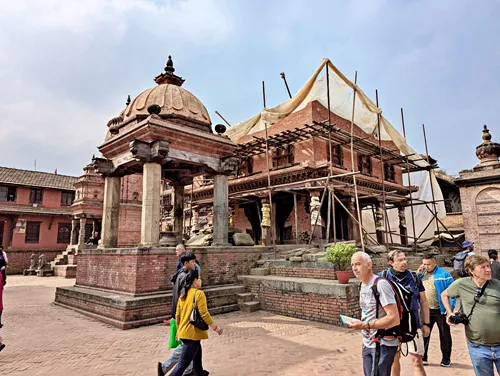Jagannath & Rameshwar Temples: Your Guide to Bhaktapur's Sacred Sites - Nepal Purple Travel Guide
(map, reviews)
This is Premium Content! To access it, please download our
Backpack and Snorkel Purple Travel GuideAcross the street (south) from the Ugrachandi & Bharib Statues you will see a group of four temples. They are the local Bhaktapur Durbar Square version of the four Char Dham temples:
The three temples that you can directly see are: On the right, and under construction, is Jagannath Temple, in the center and without walls on either side and a domed roof is the small shrine called Rameshwar Temple, and on the left and slightly offset to the back is the pagoda-style Gopinath Krishna Temple.
Behind Rameshwar Temple lies Badrinath Temple.

Here at Backpack and Snorkel Travel Guides, we typically promote self-guided walking tours.
But we realize that not everybody likes to walk by themselves in a foreign city. So, just in case that you rather go with ab guide: NO PROBLEM! Please see the Viator tours below.
free GuruWalk tours
paid Viator tours
Historic and Cultural Significance of Char Dham
The term ‘Char Dham’ literally means ‘four abodes’ or ‘four seats’ in Hindi and Sanskrit. The term refers to the four major pilgrimage sites in India. However, the concept has been adopted and localized in other regions, including the Kathmandu Valley.
In Bhaktapur Durbar Square, the Char Dham temples are a set of four smaller temples located at the western end of the square. These temples were commissioned by King Yaksha Malla in the 15th century with the specific intention of providing spiritual merit to those who were unable to undertake the arduous journey to the original Char Dham pilgrimage sites in India.
Jagannath Temple
Jagannath Temple was destroyed in the earthquake of 1934, and rebuilt as a simple rectangular building with white-washed walls. This building was destroyed in the 2015 earthquake and the temple is now being rebuilt in its original traditional Newar-style glory. Construction is still ongoing at the time of writing, but what you can see so far looks fantastic.
The temple is dedicated to Lord Jagannath, a form of Lord Vishnu and an incarnation of Krishna, worshipped widely in India and Nepal. The name ‘Jagannath’ translates to ‘Lord of the Universe’, a title that reflects his all-encompassing divinity and universal love. Lord Jagannath is particularly associated with the famous Jagannath Temple of Puri in India, and temples with the same name across South Asia often mirror that devotion on a more localized scale.
In Bhaktapur, the presence of a Jagannath Temple highlights the city’s strong ties to Vaishnavism (worship of Vishnu and his avatars), especially during the Malla period when temple construction flourished.
Rameshwar Temple
Rameshwar Temple is a shrine without walls on either side and a domed roof.
The shrine is believed to have been constructed during the reign of King Bhupatindra Malla in the late 17th or early 18th century.
The Meaning Behind the Name Rameshwar
The name Rameshwar is deeply rooted in Hindu mythology and Sanskrit.
It combines:
Ram: referring to Lord Rama, the hero of the Ramayana. Ramayana is one of the two major Sanskrit epics of ancient India - the other is Mahabharata - and is hugely influential in Indian culture, religion, and literature. The entire epic narrative revolves around his life, his trials, his adherence to dharma (righteous duty), and his eventual triumph over evil.
Ishwar: meaning God or Lord, typically used to refer to Shiva.
Together, the name means ‘Lord of Rama’, that is, Lord Shiva as worshipped by Rama. According to legend, Rama built a Shiva lingam (abstract or aniconic representation of the Hindu god Shiva in Shaivism - it is typically a cylindrical or elliptical pillar-like symbol, often placed on a circular base called a yoni, which represents the goddess Shakti) and prayed to Shiva before his epic battle with Ravana (ten-headed Dashanana or Dashagriva demon king of Lanka and the chief antagonist of Lord Rama). This act of devotion gave rise to the reverence of Shiva under the name Rameshwar, a tradition that continues in temples across South Asia, including this one in Bhaktapur.
Architecture of Rameshwar Temple
The temple’s design reflects the Malla-era love for form and function. Its lotus-like roof, supported by richly carved wooden struts, and four exquisitely carved stone pillars (much of the carvings have been washed out over the centuries) provides shelter for the Shivalinga without enclosing it, allowing devotees and visitors to see inside from all angles. The Shivalinga rests on a jalhari (a water-draining pedestal), a traditional feature found in Shiva temples.
Back to your self-guided tour
Author: Rudy at Backpack and Snorkel
Bio: Owner of Backpack and Snorkel Travel Guides. We create in-depth guides to help you plan unforgettable vacations around the world.
Other popular Purple Travel Guides you may be interested in:
Like this Backpack and Snorkel Purple Travel Guide? Pin these for later:





